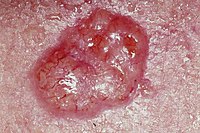
Photo from wikipedia
Dear Editor, Caplacizumab (Cablivi®) is a novel anti-von Willebrand factor (vWF) nanobody approved for the treatment of acquired thrombotic thrombocytopenic purpura (aTTP) [1]. A single-dose (10 mg) caplacizumab is given… Click to show full abstract
Dear Editor, Caplacizumab (Cablivi®) is a novel anti-von Willebrand factor (vWF) nanobody approved for the treatment of acquired thrombotic thrombocytopenic purpura (aTTP) [1]. A single-dose (10 mg) caplacizumab is given intravenously before starting plasma exchange (PEX), followed by daily (10 mg) SC injections for up to 30 days after last PEX. We collected clinical data of 60 patients between 2018 and 2019 [2, 3]. In 7 cases (> 10%), we observed local injection site reactions appearing 4 days to 4weeks after the start of the caplacizumab treatment. These skin reactions caused great uncertainty leading to an altered, off-label management in 5 cases and might interfere with the patients’ treatment outcome. The skin reactions presented as erythema with hyperreactivity around the injection site with hyperemia and itching (Fig. 1). The findings developed sooner and more pronounced with subsequent injections even at different sites. There were no significant changes in the eosinophilia count, IgE levels, or Creactive protein. Importantly, the reactions had no measurable impact on drug efficacy as vWF activity remained suppressed. The local reactions did not respond to anti-histaminic or high-dose glucocorticoid treatment. All patients were still on a steroidtapering regime with dosages ranging from 12.5 to 80 mg/day prednisolone. In one patient, the caplacizumab dosing was not altered but prednisolone increased to 30 mg/day. In two other patients, caplacizumab was first continued and later extended to a q2 dosing regimen with daily prednisolone (30 mg). In another patient, caplacizumabwas briefly interrupted before being continued in an unchanged alternate dosing regimen and 50 mg of prednisolone in addition to each injection. Caplacizumab was discontinued in 3/6 patients. In one of these 3 patients, an aTTP relapse occurred after stopping the treatment, and caplacizumab was restarted on a q2 dosing regimen together with prednisolone (12.5 mg/day). After discontinuation of caplacizumab, the skin reactions slowly disappeared. In patients with ongoing treatment, the skin reactions peaked before slowly resolving over several weeks independent of any of the abovementioned measures. All patients had a full recovery from aTTP. In the HERCULES trial, urticaria and local injection site pain were reported as an adverse event in 16.9%and1.4%ofpatients in the caplacizumab arm and 6.8% and 5.5% in the placebo arm [1] potentiallyasareaction to the freshfrozenplasmaand thePEX.[4]. In our patients, the erythema always occurred several days/weeks after the cessationofPEX.Pre-existingallergieswerenot reported. One excipient in the formulation of Cablivi is Polysorbate 80 besides sucrose, citric acid, and sodium citrate. Polysorbates are often added to stabilize new biotherapeutics such as new formulations of erythropoeitin or PCSK9i [5, 6]. Polysorbates have the potential to activate complement and may cause acute hypersensitivity reactions as well as anaphylactoid reactions and local skin reactions [7]. Further studies
Journal Title: Annals of Hematology
Year Published: 2020
Link to full text (if available)
Share on Social Media: Sign Up to like & get
recommendations!